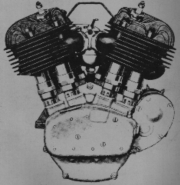Some General Info and Thoughts on Big Twin Flathead Engines
The flathead (also called a side valve) engine design has been around for many years. Harley first used it in a single cylinder version. In 1929 they came out with their first flathead v-twin ">
|
|
|
| Some General Info and Thoughts on Big Twin Flathead Engines The flathead (also called a side valve) engine design has been around for many years. Harley first used it in a single cylinder version. In 1929 they came out with their first flathead v-twin , a 45 cubic inch. A year later, in 1930, Harley came out with their first "big twin" flathead, a 74 cubic inch with the "V" series of model designation. 1935 was the year that the V series received its first 80 cubic inch engine. 1936 saw the last of the V series flatheads and along with it the last of the "total loss" oil systems. Yes, that's right; hard as it is to imagine in today's high tech world, early Harley's did not have a circulating oil system. Once oil had served its purpose, it ended up on the ground.
This change to a circulating oil system is one of the most notable changes differentiating the new "U" series from the older "V" series. 1937 and later U models all share the same 4 9/32" stroke. Both a 74 and 80 inch engine were still offered, the difference being in the bore size. The 74 had a 3 5/16" bore while the 80 had a 3 7/16" bore. A popular hop up "back in the day" was to use these longer stroke flathead flywheels in knuckle motors in place of their 3 1/2" stroke (61") or 3 31/32" stroke (74") flywheels. Harley continued to produce 80" flatheads until 1940, and the 74" until 1948. So how practical is it to "hop up" a Harley flathead? The answer to that question will probably be different for every owner. How far you chose to go in modifying your flathead will, to a great extent, depend a on the use it will be put to, and the amount of money you have available to do it. The mods done on a motor that is your only ride, and daily driver, will quite likely tend to be milder than if you own 3 bikes and this one is "just for fun". Flatheads have been modified to increase their performance for .... well, probably about as long as their have been flatheads. There are some mods that might be practical from a longevity standpoint which are not practical financially for many of us. Obviously if you are bothering to read this, there is probably something more than ultimate horsepower motivating you, or you would not be contemplating hopping up a flathead; you would be replacing it with something more modern. But some of us just see the beauty in making something antique run way faster than it was designed to run. Guess that's part of what makes a person a "gearhead". Which modifications you decide to do to your flathead may hinge to a big degree on the condition that it is in right now, unless money is not a issue. Stroker flywheels are not cheap, nor is the labor for installation, but unless taken to extremes are probably not a big factor in longevity at the rpm most street engines will be run. Flywheels can become unusable, usually due to damaged tapers. If such is the case with yours, then stroker flywheels become an attractive option. Increasing the duration of the cams will get more air in .... and out; increasing power. Again, unless taken to extremes, this will not decrease longevity to any great extent. Cam duration will, however, effect the rpm range at which the engine will make its power. A higher lift cam will tend to increase the power over the entire rpm range, assuming the heads flow more at the higher lift than they did at the stock cam's lift. Keep in mind however that nearly all cams that have increased lift also have increased duration. This is probably not something that should be a matter of concern for a couple of reasons. #1 Most cam grinders know what they are doing, and won't steer you wrong if you tell them what mods you have done on your engine, and what you are looking for in performance. #2 If you are having your stock cams reground, the material that the cam grinder has to work with is probably not enough to create a cam that is going to be too "hot" for your motor. Having your stock cams reground to "hotter" specs could possibly even save you some money if the lobes have unacceptable wear , but the shafts are still usable. Porting, done correctly, is win/win situation. Porting is the act of physically modifying the shape and/or size of the passages from the carb to the intake valve and from the exhaust valve to the exhaust pipe. Without a flowbench you will have a tough time measuring the results of any modifications you make here. On flathead engines, usually the term "relieve" goes hand in hand with "porting" (ie.: port and relieve ) Relieving is the act of physically removing material from the cylinder between the valve and the bore to aid in air flow. While this is a time tested modification, it will have the effect of lowering the compression ratio. Popular opinion is that to make power with a flathead, airflow is more important than compression ratio. I have some thoughts of my own as to the method that is commonly employed in relieving, which I will share later in this series of posts
|
|
|
 V series Engine
V series Engine